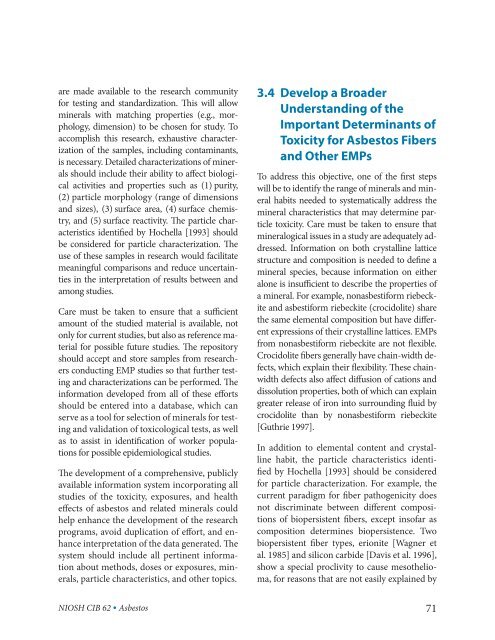Asbestos Fibers and Other Elongate Mineral Particles: State of the ...
Asbestos Fibers and Other Elongate Mineral Particles: State of the ...
Asbestos Fibers and Other Elongate Mineral Particles: State of the ...
- No tags were found...
You also want an ePaper? Increase the reach of your titles
YUMPU automatically turns print PDFs into web optimized ePapers that Google loves.
are made available to <strong>the</strong> research community<br />
for testing <strong>and</strong> st<strong>and</strong>ardization. This will allow<br />
minerals with matching properties (e.g., morphology,<br />
dimension) to be chosen for study. To<br />
accomplish this research, exhaustive characterization<br />
<strong>of</strong> <strong>the</strong> samples, including contaminants,<br />
is necessary. Detailed characterizations <strong>of</strong> minerals<br />
should include <strong>the</strong>ir ability to affect biological<br />
activities <strong>and</strong> properties such as (1) purity,<br />
(2) particle morphology (range <strong>of</strong> dimensions<br />
<strong>and</strong> sizes), (3) surface area, (4) surface chemistry,<br />
<strong>and</strong> (5) surface reactivity. The particle characteristics<br />
identified by Hochella [1993] should<br />
be considered for particle characterization. The<br />
use <strong>of</strong> <strong>the</strong>se samples in research would facilitate<br />
meaningful comparisons <strong>and</strong> reduce uncertainties<br />
in <strong>the</strong> interpretation <strong>of</strong> results between <strong>and</strong><br />
among studies.<br />
Care must be taken to ensure that a sufficient<br />
amount <strong>of</strong> <strong>the</strong> studied material is available, not<br />
only for current studies, but also as reference material<br />
for possible future studies. The repository<br />
should accept <strong>and</strong> store samples from researchers<br />
conducting EMP studies so that fur<strong>the</strong>r testing<br />
<strong>and</strong> characterizations can be performed. The<br />
information developed from all <strong>of</strong> <strong>the</strong>se efforts<br />
should be entered into a database, which can<br />
serve as a tool for selection <strong>of</strong> minerals for testing<br />
<strong>and</strong> validation <strong>of</strong> toxicological tests, as well<br />
as to assist in identification <strong>of</strong> worker populations<br />
for possible epidemiological studies.<br />
The development <strong>of</strong> a comprehensive, publicly<br />
available information system incorporating all<br />
studies <strong>of</strong> <strong>the</strong> toxicity, exposures, <strong>and</strong> health<br />
effects <strong>of</strong> asbestos <strong>and</strong> related minerals could<br />
help enhance <strong>the</strong> development <strong>of</strong> <strong>the</strong> research<br />
programs, avoid duplication <strong>of</strong> effort, <strong>and</strong> enhance<br />
interpretation <strong>of</strong> <strong>the</strong> data generated. The<br />
system should include all pertinent information<br />
about methods, doses or exposures, minerals,<br />
particle characteristics, <strong>and</strong> o<strong>the</strong>r topics.<br />
NIOSH CIB 62 • <strong>Asbestos</strong><br />
3.4 Develop a Broader<br />
Underst<strong>and</strong>ing <strong>of</strong> <strong>the</strong><br />
Important Determinants <strong>of</strong><br />
Toxicity for <strong>Asbestos</strong> <strong>Fibers</strong><br />
<strong>and</strong> <strong>O<strong>the</strong>r</strong> EMPs<br />
To address this objective, one <strong>of</strong> <strong>the</strong> first steps<br />
will be to identify <strong>the</strong> range <strong>of</strong> minerals <strong>and</strong> mineral<br />
habits needed to systematically address <strong>the</strong><br />
mineral characteristics that may determine particle<br />
toxicity. Care must be taken to ensure that<br />
mineralogical issues in a study are adequately addressed.<br />
Information on both crystalline lattice<br />
structure <strong>and</strong> composition is needed to define a<br />
mineral species, because information on ei<strong>the</strong>r<br />
alone is insufficient to describe <strong>the</strong> properties <strong>of</strong><br />
a mineral. For example, nonasbestiform riebeckite<br />
<strong>and</strong> asbestiform riebeckite (crocidolite) share<br />
<strong>the</strong> same elemental composition but have different<br />
expressions <strong>of</strong> <strong>the</strong>ir crystalline lattices. EMPs<br />
from nonasbestiform riebeckite are not flexible.<br />
Crocidolite fibers generally have chain-width defects,<br />
which explain <strong>the</strong>ir flexibility. These chainwidth<br />
defects also affect diffusion <strong>of</strong> cations <strong>and</strong><br />
dissolution properties, both <strong>of</strong> which can explain<br />
greater release <strong>of</strong> iron into surrounding fluid by<br />
crocidolite than by nonasbestiform riebeckite<br />
[Guthrie 1997].<br />
In addition to elemental content <strong>and</strong> crystalline<br />
habit, <strong>the</strong> particle characteristics identified<br />
by Hochella [1993] should be considered<br />
for particle characterization. For example, <strong>the</strong><br />
current paradigm for fiber pathogenicity does<br />
not discriminate between different compositions<br />
<strong>of</strong> biopersistent fibers, except ins<strong>of</strong>ar as<br />
composition determines biopersistence. Two<br />
biopersistent fiber types, erionite [Wagner et<br />
al. 1985] <strong>and</strong> silicon carbide [Davis et al. 1996],<br />
show a special proclivity to cause meso<strong>the</strong>lioma,<br />
for reasons that are not easily explained by<br />
71

















